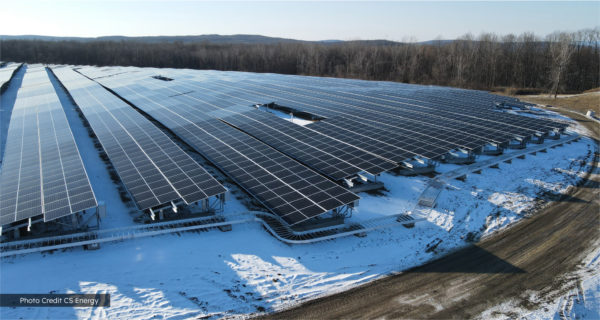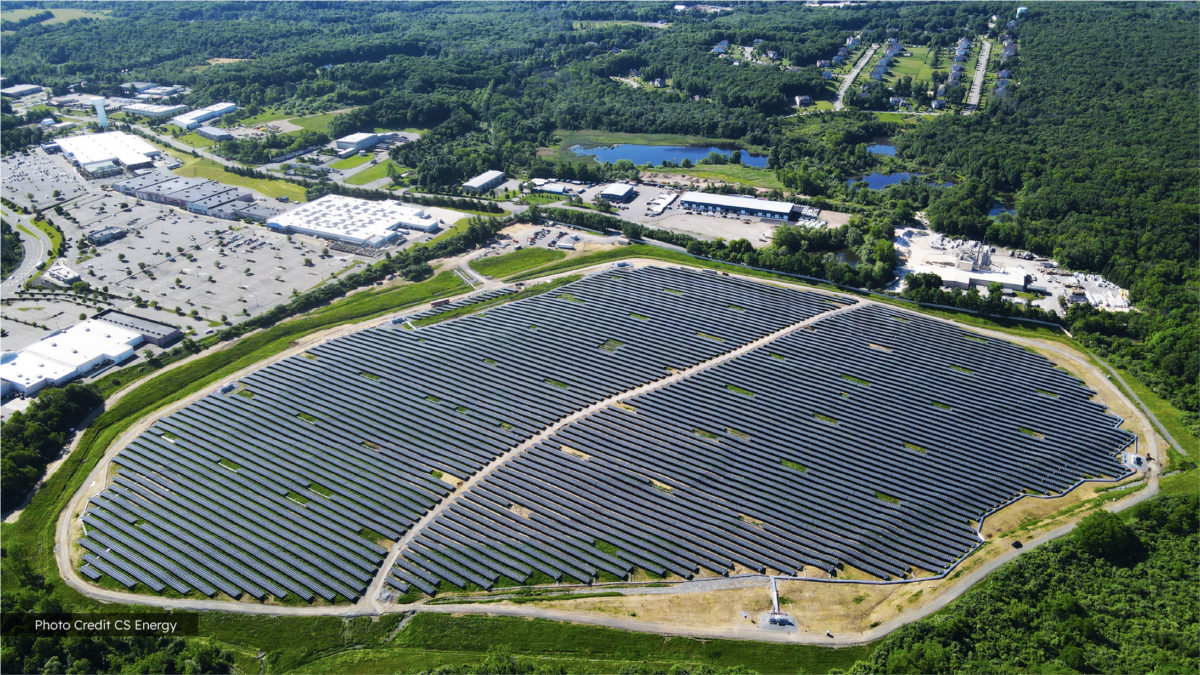There are over 10,000 closed landfills in the United States, and it has been determined that closed landfills could host more than 60 GW of solar capacity – enough to power 7.8 million homes, according to a 2021 study by RMI, and this figure is rapidly increasing with the growing number of landfill projects in the past two years. CEP Renewables, for example, currently has 16 landfill or brownfield solar projects under development, and the company reports that its most recently completed 25.6 MW Mount Olive, project is the largest landfill solar project in North America.
CEP was selected by the Township of Mount Olive, New Jersey to redevelop the former Combe Fill North Landfill Superfund site into a revenue generating, solar energy asset. The landfill had been operating as a municipal sanitary landfill for fifteen years. In the early 1980s the owner went bankrupt, the property was abandoned and the landfill closed.
Like many former landfills, the property was listed on the United States Environmental Protection Agency’s (EPA) National Priorities List of Superfund sites. Due to its improper closure, runoff from the landfill was draining into local creeks and contaminating groundwater that nearly 10,000 community members depended on.
The town was also losing tax revenue, as $2.3 million was still owed in back taxes on the abandoned land. Most commercial developers also did not want to purchase the property because environmental restrictions and New Jersey environmental requirements meant that no commercial uses could be built on the sensitive, capped landfill without risking piercing the landfill’s protective seal. The New Jersey Department of Environmental Protection (NJDEP) eventually determined that it would only allow a solar facility to be built on this former landfill site and the Township adopted a redevelopment plan permitting a solar array.
Public-private partnership
CEP’s team of landfill and brownfield experts negotiated a unique public-private partnership with the Township and NJDEP that allowed CEP to purchase the landfill by way of the redevelopment and tax lien foreclosure process. As part of the agreement, CEP agreed to pay the back taxes to the Township over time in addition to redeveloping the land into a tax revenue-producing solar field.
The deal also involved an administrative consent order between the NJDEP and CEP that stated that in exchange for CEP agreeing to redevelop the land and take over long-term maintenance of the cap, the State of New Jersey would assume all liability for air pollution and water contamination associated with the site.
The solar installation includes approximately 57,000 450 W Boviet solar modules with a Toshiba Mitsubishi Electric Industrial Systems (TMEIS) inverter. The project won the 2021 Award for Innovation in Governance from the New Jersey League of Municipalities, and it now serves as a financial and legal model for the myriad other closed landfill sites throughout the U.S. to follow.
“Only a small fraction of the 10,000 closed landfills across the U.S. have been converted into solar fields. The unique structure we used to implement this project now serves as a model that can be leveraged to redevelop more closed landfills into revenue producing assets that facilitate cleaner air, tax revenue, jobs, and more affordable energy for residents,” said Chris Ichter, executive vice president at CEP Renewables
Landfill settlement analysis
Landfill settlement analysis is critical in order to ensure that the design and construction preparation is adequate for installing the solar array atop the landfill, while avoiding damage to its protective layer. The stability and slopes of various sections of the landfill need to be determined through this analysis, which will then help with specifying where the best locations to enable site access are, given that there will be obstructions that need to be considered.

Image: CEP Renewables
CS Energy completed a thorough landfill settlement analysis on this site prior to designing and engineering the solar installation and developing the site access plans. The company was able to use its experience on over 200 MW of landfill solar projects to conduct this analysis, which included the use of ground penetration radar, to determine landfill weight requirements and the safest access points. CS Energy planned out the cable tray locations to ensure access in and out of each of these key areas, which is crucial not only for the installation of the solar system, but also for ongoing operations and maintenance work in the long term.
Based on this analysis, CS Energy used only tracked equipment and, where required, low ground bearing pressure machines. Ultimately, CS Energy was able to design and build this project on time and on budget, without affecting the landfill cap, as a result of its significant preparation work and extremely cautious construction at each stage of the project’s design and construction.
Value engineering
Being the largest landfill solar project in North America, every slight increase in product cost is multiplied and compounded across the entirety of this immense project. Terrasmart, the racking and mounting provider, had seen concrete costs rising, which affected the cost of its ballast blocks. This presented a challenge, as mounting solution companies need to be able to minimize the tilt of the solar array in order to reduce the amount and size of blocks needed, while still ensuring high energy yields from the solar array.
Additionally, in cold climate locations, the solar array tilt cannot be so low that an inordinate amount of snow is able to pile up and cause a great deal of stress on the racking system. This is particularly important for projects like the Mount Olive project, which are located on top of a sensitive landfill cap that cannot be pierced.
The GLIDE solution
Leveraging its experience on several other large-scale landfill solar projects in cold weather locations, Terrasmart was able to successfully design and engineer their GLIDE ballasted mounting solution for this project such that the cost of the blocks was reduced by 50 percent. From wind studies to countless solar generation analyses, Terrasmart determined the optimal tilt and block size to help CEP meet its project budget and energy production goals – all while protecting the sensitive landfill cap.
With over 20 GW of solar deployed across 4,800 solar systems, including its legacy business RBI Solar’s decades of experience in solar landfill development, the new Terrasmart has become the leading provider of solar racking technologies that provide solutions for projects located on all types of terrain.
Landfill solar projects often require fixed-tilt, ballasted mounting solutions that do not pose a risk of piercing or otherwise damaging the landfill cap, which could result in the spread of hazardous contaminants. In order to ensure the myriad integration and delivery deadlines for the skid mount system are met, close collaboration with project partners is paramount.
Having completed over 4,000 skids, Lindsay Precast was able to leverage its steel skid manufacturing and integration capabilities, including on many landfill solar projects. Lindsay Precast’s deep understanding of the entire value chain of a solar project and ability to efficiently provide quotes and accurate schedule estimates made this challenging project as streamlined as possible.
Precast has also completed countless projects with Terrasmart and this project marks the company’s seventh project with CS Energy, which includes the award-winning Cuyahoga landfill solar project. The decades of experience Lindsay Precast has spent working with these partners enabled the skid mounting solutions for this project to be seamlessly integrated and delivered on time and within budget.
Benefits and long-term impact
As a result of CEP, CS Energy, Terrasmart and Lindsay Precast’s extensive landfill solar project experience and collaboration, the Township of Mount Olive was able to not only recoup approximately $2.3 million in back taxes but will also now benefit from future taxes that this property will provide. The electricity generated by the array is enough to power over 4,000 homes.
The 25.6 MW dc of solar electric power contributes to the State of New Jersey’s aggressive renewable energy production goals. After 40 years, the property now has a long-term owner – CEP Renewables – that will be responsible for maintaining the landfill cap for the duration of the life of the facility. The Mount Olive project now serves as a model for the plethora of other closed landfill sites throughout the United States, both in terms of the redevelopment process as well as the design and construction execution, while providing cleaner air and more affordable clean energy for local communities.
CEP is currently under development on at least 16 other landfill or brownfield redevelopment projects in New Jersey. However, without a dramatic change in the state’s policy and attitude toward these projects, creating more successes like Mount Olive will prove difficult, if not impossible.
These projects are all certified by the New Jersey Board of Public Utilities (NJBPU) under what is known as the subsection “t” certification process. Subsection “t” is a subsection of the Solar Act of 2012 that provides a regulatory framework by which landfill and brownfield redevelopment projects receive state incentives. Once certified under subsection “t,” a project has two years to complete commercial energization. That timeframe is currently impossible due to a multi-year interconnection moratorium announced in April 2022 by PJM Interconnection, LLC, the regional interconnection organization that monitors New Jersey’s and other states’ electrical grids.
Due to the PJM delays, most of CEP’s projects will not be eligible for interconnection until 2027 or 2028 at the earliest.
Although the NJBPU is aware of this, the most the Board has been willing to do is extend the 2-year construction period by up to one 12-month extension – which is not nearly enough time based on PJM’s published information regarding the delays and PJM’s interconnection reform process, which was just recently approved by the Federal Energy Regulatory Commission.
CEP has petitioned the Board to reconsider the 12-month extension to provide sufficient time to allow these important and transformative projects to interconnect to the regional grid. Unless the state and the Board get behind these projects and allow them the time necessary to proceed, it is unlikely that the state will see more successes like Mount Olive.
CEP remains optimistic that the Mount Olive project can be replicated on additional closed landfills throughout the state with the support of the state and NJBPU, as landfill redevelopment solar projects are necessary to mitigate climate change and provide precious funds, cleaner air and more affordable clean energy to local communities, particularly those that have been burdened by these economically and environmentally destructive properties for decades.
Lisa DeMarco, communications director at TwentyTwo & Brand.
The views and opinions expressed in this article are the author’s own, and do not necessarily reflect those held by pv magazine.
This content is protected by copyright and may not be reused. If you want to cooperate with us and would like to reuse some of our content, please contact: editors@pv-magazine.com.








I feel bad for the installers. PeW, PeW, PeW. Nothing Quite Like the Odiferous Smells on a construction site over an Old Landfill… 🙁